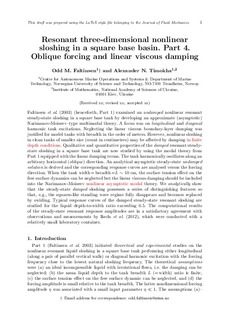| dc.contributor.author | Faltinsen, Odd Magnus | |
| dc.contributor.author | Timokha, Alexander | |
| dc.date.accessioned | 2017-10-18T08:06:35Z | |
| dc.date.available | 2017-10-18T08:06:35Z | |
| dc.date.created | 2017-08-08T13:08:11Z | |
| dc.date.issued | 2017 | |
| dc.identifier.citation | Journal of Fluid Mechanics. 2017, 822 139-169. | nb_NO |
| dc.identifier.issn | 0022-1120 | |
| dc.identifier.uri | http://hdl.handle.net/11250/2460684 | |
| dc.description.abstract | Faltinsen et al. (J. Fluid Mech., vol. 487, 2003, pp. 1–42) (henceforth, Part 1) examined an undamped nonlinear resonant steady-state sloshing in a square-base tank by developing an approximate (asymptotic) Narimanov–Moiseev-type multimodal theory. The focus was on longitudinal and diagonal harmonic tank excitations. Neglecting the linear viscous boundary-layer damping was justified for model tanks with breadths of the order of metres. However, nonlinear sloshing in clean tanks of smaller size (count in centimetres) may be affected by damping in finite depth conditions. Qualitative and quantitative properties of the damped resonant steady-state sloshing in a square-base tank are now studied by using the modal theory from Part 1 equipped with the linear damping terms. The tank harmonically oscillates along an arbitrary horizontal (oblique) direction. An analytical asymptotic steady-state undamped solution is derived and the corresponding response curves are analysed versus the forcing direction. When the tank width = breadth = L~10 cm, the surface tension effect on the free-surface dynamics can be neglected but the linear viscous damping should be included into the Narimanov–Moiseev nonlinear asymptotic modal theory. We analytically show that the steady-state damped sloshing possesses a series of distinguishing features so that, e.g. the square-like standing wave regime fully disappears and becomes replaced by swirling. Typical response curves of the damped steady-state resonant sloshing are studied for the liquid depth-to-width ratio exceeding 0.5. The computational results of the steady-state resonant response amplitudes are in a satisfactory agreement with observations and measurements by Ikeda et al. (J. Fluid Mech., vol. 700, 2012, pp. 304–328), which were conducted with a relatively small laboratory container. | nb_NO |
| dc.language.iso | eng | nb_NO |
| dc.publisher | Cambridge University Press (CUP) | nb_NO |
| dc.title | Resonant three-dimensional nonlinear sloshing in a square-base basin. Part 4. Oblique forcing and linear viscous damping | nb_NO |
| dc.type | Journal article | nb_NO |
| dc.type | Peer reviewed | nb_NO |
| dc.description.version | acceptedVersion | nb_NO |
| dc.source.pagenumber | 139-169 | nb_NO |
| dc.source.volume | 822 | nb_NO |
| dc.source.journal | Journal of Fluid Mechanics | nb_NO |
| dc.identifier.doi | 10.1017/jfm.2017.263 | |
| dc.identifier.cristin | 1484851 | |
| dc.relation.project | Norges forskningsråd: 223254 | nb_NO |
| dc.description.localcode | © Cambridge University Press 2017. This is the authors’ accepted and refereed manuscript to the article. LOCKED until 2.12.2017 due to copyright restrictions. | nb_NO |
| cristin.unitcode | 194,64,20,0 | |
| cristin.unitname | Institutt for marin teknikk | |
| cristin.ispublished | true | |
| cristin.fulltext | postprint | |
| cristin.qualitycode | 2 | |
